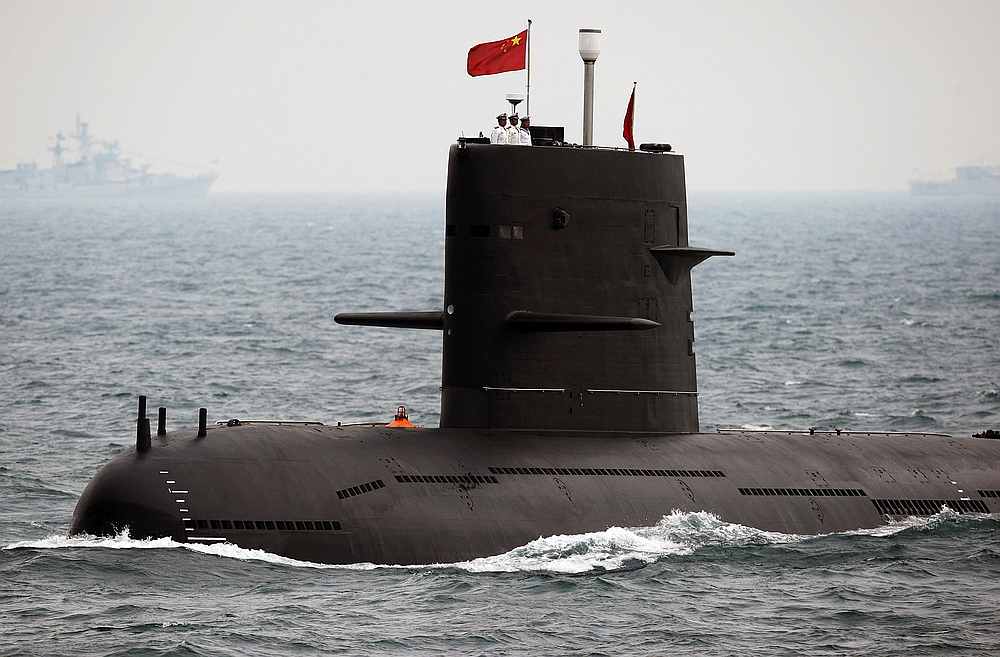Pentagon warns on risk of Chinese submarines in Arctic

A Chinese Navy submarine takes part in an international fleet review in Qingdao, Shandong province, April 23, 2009. — China Army/Navy Guang Niu/Pool pic via Reuters
WASHINGTON D.C., May 3, 2019, Reuters. Deepening Chinese activities in the Arctic region could also pave the way for a strengthened military presence, including the deployment of submarines to act as deterrents against nuclear attack, the Pentagon said in a report released yesterday, reported the MalayMail.
The assessment is included in the US military’s annual report to Congress on China’s armed forces and follows Beijing’s publication of its first official Arctic policy white paper in June.
In that paper, China outlined plans to develop shipping lanes opened up by global warming to form a “Polar Silk Road” — building on President Xi Jinping’s signature Belt and Road Initiative.
China, despite being a non-Arctic state, is increasingly active in the polar region and became an observer member of the Arctic Council in 2013. That has prompted concerns from Arctic states over Beijing’s long-term strategic objectives, including possible military deployments.
The Pentagon report noted that Denmark has expressed concern about China’s interest in Greenland, which has included proposals to establish a research station, establish a satellite ground station, renovate airports and expand mining.
“Civilian research could support a strengthened Chinese military presence in the Arctic Ocean, which could include deploying submarines to the region as a deterrent against nuclear attacks,” the report said.
The Pentagon report noted that China’s military has made modernising its submarine fleet a high priority. Its navy operates four nuclear-powered ballistic missile submarines, six nuclear-powered attack submarines and 50 conventionally-powered attack submarines, it said.
“The speed of growth of the submarine force has slowed and (it) will likely grow to between 65 and 70 submarines by 2020,” the report predicted.
The United States and its allies, in turn, are expanding their anti-submarine naval deployments across East Asia. This includes stepped-up patrols of America’s advanced, sub-hunting P-8 Poseidon planes out of Singapore and Japan.
Taiwan contingency
The expansion of China’s submarine forces is just one element of a broad — and costly — modernisation of its military, which US experts say is designed largely to deter any action by America’s armed forces.
Although Beijing’s official defence budget for 2018 was US$175 billion (RM723.2 billion), the Pentagon estimated that China’s budget actually topped US$200 billion, when including research, development and foreign weapons procurement.
It estimated that China’s official defense budget would likely grow to about US$260 billion by 2022.
Much of China’s military doctrine is focused on self-ruled Taiwan, which Beijing sees as a renegade province.
On January 2, Xi said in a speech that China reserved the right to use force to bring Taiwan under its control but would strive to achieve peaceful “reunification.”
The Pentagon report outlined a number of potential scenarios that China might take if Beijing decides to use military force on Taiwan, including a comprehensive campaign “designed to force Taiwan to capitulate to unification, or unification dialogue.”
But the US analysis appeared to downplay prospects for a large-scale amphibious Chinese invasion, saying that could strain its armed forces and invite international intervention.
It also noted the possibility of limited missile strikes.
“China could use missile attacks and precision air strikes against air defense systems, including air bases, radar sites, missiles, space assets, and communications facilities to degrade Taiwan’s defences, neutralise Taiwan’s leadership, or break the Taiwan people’s resolve,” the report said.
China has repeatedly sent military aircraft and ships to circle the island on drills in the past few years and worked to isolate Taiwan internationally, whittling down its few remaining diplomatic allies.
It has also strongly objected to US warship passages through the Taiwan Strait, which have greatly increased in frequency in the past year.
Taiwan’s military is significantly smaller than China’s, a gap that the Pentagon noted is growing year by year.
Recognising the disparity, the Pentagon report noted: “Taiwan has stated that it is working to develop new concepts and capabilities for asymmetric warfare.”